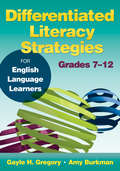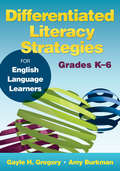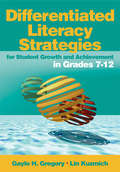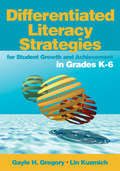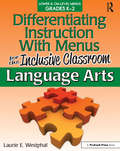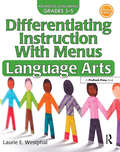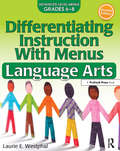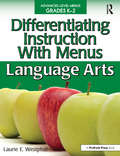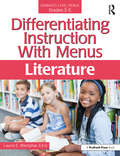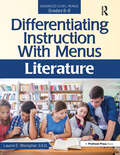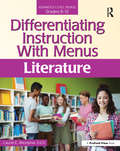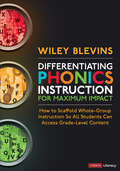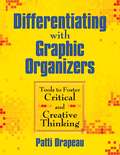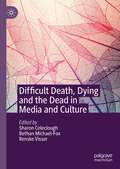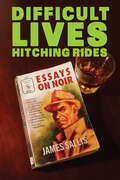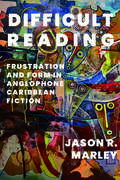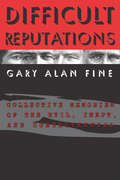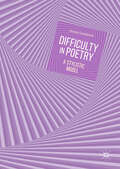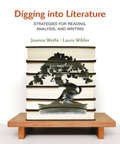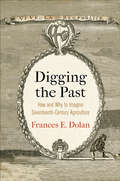- Table View
- List View
Differentiated Literacy Instruction: Assessing, Grouping, Teaching
by Michael C. McKenna John Z. Strong Zoi A. Philippakos Sharon WapoleThe goal of this book is to answer the question What is differentiated instruction? It offers pre-service and in-service teachers the background and foundational skills they will need to understand, plan for, and achieve effective differentiated literacy instruction in their classrooms, based on individual student needs. Chapters provide essential information about how to analyze and synthesize data from assessments, use the information for grouping students, and then plan and implement differentiated instruction. Many specific, hands-on descriptions and exhibits are provided. Case studies of real classrooms demonstrate effective differentiated instructional techniques. End-of-chapter Practical Application questions allow readers to apply chapter concepts as they learn to motivate and teach diverse learners.
Differentiated Literacy Strategies for English Language Learners, Grades 7–12
by Gayle H. Gregory Amy J. Burkman100 ways to keep adolescent ELLs engaged This versatile handbook is for middle school and high school educators who need to differentiate literacy instruction for adolescent ELL students at various stages of literacy competency. Adapted from the highly successful Differentiated Literacy Strategies for Student Growth and Achievement in Grades 7–12, the authors use brain-based strategies and texts that appeal to older learners who may have had interrupted formal education or come from newly arrived immigrant populations. More than 100 hands-on tools help teachers develop students’ competencies in: Content areas, including vocabulary, concept attainment, and comprehension Technology, such as information searching, evaluation, and synthesis Creative applications and 21st century skills ·
Differentiated Literacy Strategies for English Language Learners, Grades K–6
by Gayle H. Gregory Amy J. BurkmanEffective ways to help ELLs excel The key to successfully teaching English learners is focusing on literacy. Adapted from the highly successful Differentiated Literacy Strategies for Student Growth and Achievement in Grades K–6, this book provides a wealth of practical literacy strategies tailored for students who have had interrupted formal education or come from newly arrived immigrant populations. Teachers will find an instructional and assessment framework designed to promote these critical competencies: Functional literacy in phonics, spelling, and reading; Content-area literacy for vocabulary, concept attainment, and comprehension; Technological literacy for information searching, evaluation, and synthesis; Innovative literacy for creativity, growth, and lifelong learning.
Differentiated Literacy Strategies for Student Growth and Achievement in Grades 7-12
by Gayle H. Gregory Linda M. KuzmichUse high pay-off instructional strategies to accelerate literacy learning in the differentiated classroom! From best-selling authors Gregory and Kuzmich comes a versatile handbook for middle school and high school educators who need to differentiate literacy instruction for adolescent and teen learners at different stages of development along the literacy continuum. Containing more than 100 planning models, checklists, rubrics, lesson plans, and more, this book aids teachers in: Pre-assessing adolescent and teen learners for literacy skills and competencies Selecting and differentiating an array of appropriate instructional strategies Using literacy models that can accelerate learning to help diverse learners grow as fast and as far as they can in literacy
Differentiated Literacy Strategies for Student Growth and Achievement in Grades K-6
by Gayle H. Gregory Linda M. KuzmichThe most effective literacy strategies for ALL the young readers, writers, speakers, and listeners in your diverse classroom! Emerging learners, developing learners, and fluent learners at all stages of development along the literacy continuum-those are the learners in today’s elementary classrooms. With this latest work, noted authors Gregory and Kuzmich give teachers an instructional and assessment framework designed to promote multiple competencies in literacy. With a focus on research-based, data-driven, and differentiated strategies, teachers are offered a guide to: Pre-assessing diverse learners for literacy skills, competencies, learning styles, and learning gaps Implementing a broad array of high-payoff and developmentally appropriate strategies Creating units, lessons, and adjustable assignments that address multiple competencies in literacy learning
Differentiated Reading Instruction
by Michael Mckenna Sharon WalpoleThis bestselling book provides a research-based framework for making differentiated instruction work in the primary grades. It includes scientifically validated techniques for teaching each component of the beginning reading program. The authors describe how to use assessment to form differentiated small groups and monitor student progress; plan which skills to target and when; and implement carefully selected instructional strategies. Vivid classroom examples illustrate what differentiated instruction looks like in action in each of the primary grades. For additional helpful resources, including classroom-ready lesson plans, teachers can purchase the complementary volume, How to Plan Differentiated Reading Instruction Resources for Grades K-3.
Differentiating Instruction With Menus for the Inclusive Classroom: Language Arts (Grades K-2)
by Laurie E. WestphalDifferentiating Instruction With Menus for the Inclusive Classroom: Language Arts for grades K-2 offers teachers everything needed to create a student-centered learning environment based on choice. This book provides seven different types of menus that students can use to select exciting products that they will develop so teachers can assess what has been learned—instead of using a traditional worksheet format. Topics addressed include genres, books, and mechanics. Differentiating Instruction With Menus for the Inclusive Classroom: Language Arts provides numerous types of leveled menus that lower and on-level primary-age students can use to select exciting products to demonstrate learning. Menus with similar formats but geared toward varying ability levels allow teachers to differentiate easily. Using the creative and challenging choices found in Meal menus, Tic-Tac-Toe menus, Target-Based List menus, 2-5-8 menus, Give Me 5 menus, Three-Shape menus, and Pick 3 menus, students will look forward to sharing their newfound knowledge throughout the year. Also included are specific guidelines for products, rubrics for assessing student products, and teacher introduction pages for each menu. This is a must-have for any teacher wanting to differentiate for a wide range of learners!Grades K-2
Differentiating Instruction With Menus: Language Arts (Grades 3-5)
by Laurie E. WestphalThe best-selling Differentiating Instruction With Menus series has helped teachers nationwide differentiate instruction for their high-ability learners with easy-to-use menus and exciting tools to challenge and reach gifted and advanced students in the classroom. Each book includes an updated, student-friendly rubric that can assess different types of products, free choice proposal forms to encourage independent study, and new and favorite challenging menus to meet the needs of these diverse higher level learners. Readers will also be able to save time by using updated guidelines that reflect changes in technology for each of the products included in the menus and find direct alignment with standards approved in recent years. Topics addressed in Differentiating Instruction With Menus: Language Arts (Grades 3-5, 2nd ed.) include genres, writing skills, and mechanics.Grades 3-5
Differentiating Instruction With Menus: Language Arts (Grades 6-8)
by Laurie E. WestphalThe best-selling Differentiating Instruction With Menus series has helped teachers nationwide differentiate instruction for their high-ability learners with easy-to-use menus and exciting tools to challenge and reach gifted and advanced students in the classroom. Each book includes an updated, student-friendly rubric that can assess different types of products, free choice proposal forms to encourage independent study, and new and favorite challenging menus to meet the needs of these diverse higher level learners. Readers will also be able to save time by using updated guidelines that reflect changes in technology for each of the products included in the menus and find direct alignment with standards approved in recent years. Topics addressed in Differentiating Instruction With Menus: Language Arts (Grades 6-8, 2nd ed.) include genres, writing skills, and mechanics.Grades 6-8
Differentiating Instruction With Menus: Language Arts (Grades K-2)
by Laurie E. WestphalThe Differentiating Instruction With Menus series offers teachers exciting tools to challenge and reach both gifted and advanced students in the classroom. Whether these students need enrichment, choice in independent practice, or even additional academic options resulting from curriculum compacting, these books provide teachers a complete ready-to-use resource. Each book includes a rubric that can assess different types of products, free choice proposal forms to encourage independent study, specific guidelines for each of the products included in the menus to save the teacher time, and challenging menus to meet the needs of these diverse higher level learners.Differentiating Instruction With Menus: Language Arts (Grades K-2) contains attractive reproducible menus, based on the levels of Bloom's revised taxonomy, that students can use as a guide when making decisions about which products they will develop after they study a major concept or unit. Topics addressed include book genres, mechanics, and literature.The products included on the menu are carefully selected from various learning styles to build students' excitement and so that teachers can more accurately assess the depth of what has been learned. Using creative and challenging choices found in Three-Shape Menus, Tic-Tac-Toe Menus, Meal Menus, Give Me Five Menus, 2-5-8 Menus, and List Menus, students will look forward to sharing their newfound knowledge throughout the year!Grades K-2
Differentiating Instruction With Menus: Literature (Grades 3-5)
by Laurie E. WestphalDifferentiating Instruction With Menus: Literature (Grades 3-5):
Differentiating Instruction With Menus: Literature (Grades 6-8)
by Laurie E. WestphalDifferentiating Instruction With Menus: Literature (Grades 6-8):
Differentiating Instruction With Menus: Literature (Grades 9-12)
by Laurie E. WestphalDifferentiating Instruction With Menus: Literature (Grades 9-12):
Differentiating Instruction and Assessment for English Language Learners: A Guide for K-12 Teachers
by Stephaney Jones-Vo Shelley FairbairnThe notion that we must explicitly teach language within all academic classes is gaining ground today. . . . This guide is packed with ideas for purposeful and differentiated language instruction and assessment that can be applied in most content classrooms. . . . I predict this second edition will be as popular with teachers facing the challenges of educating ELLs as it will be in university teacher pre-service programs. As teachers . . . make use of the strategies, they will begin to share the excitement I felt at seeing a guide that addresses language differentiation for ELLs.Tim Boals, Executive Director, WIDA Consortium <p><p>What's New to the Second Edition?- Updated student demographics that show the range of English language learners (ELLs) we find in the United States, with attention to home language, prior schooling, and cultural background- A new chapter on teaching content and language to diverse learners that: aligns with new learning standards (e.g., Next Generation, College- and Career-Ready, Common Core) and language development progressions (e.g., WIDA, ELPA21, NY, CA, TX); prepares teachers to teach language and literacy across content areas; examines academic language at the word, sentence, and discourse levels.- An improved differentiating instruction and assessment template that draws teachers' attention to the language demands of content-area instruction- Stronger emphasis on teacher collaboration, leadership, and innovative teacher-directed approaches to professional learning- Includes an updated quick-reference chart of differentiation strategies by ELD levels for teachers' classroom use.
Differentiating Phonics Instruction for Maximum Impact: How to Scaffold Whole-Group Instruction So All Students Can Access Grade-Level Content (Corwin Literacy)
by Wiley BlevinsTeacher be nimble, teacher be quick—the routines in this book make phonics learning stick. Author Wiley Blevins is renowned for changing the way educators think about teaching children to read, helping thousands of teachers implement effective phonics instruction. Now, Blevins gets us to think in powerful new ways about differentiating whole-class phonics lessons, so students at every skill level can engage. With Blevins’ trademark clarity, Differentiating Phonics Instruction for Maximum Impact provides: High-impact routines that focus on the skills known to develop students’ literacy best. Differentiated application of these routines—with fun multi-modal games and variations—for students working on- below-, and above grade-level expectations, and for multilingual learners Guidelines for creating skills-based small groups for more intensive work "Look-fors" for teachers and supervisors, to know when instruction is working or needs to be adjusted Several reproducible phonics and spelling assessments for placement, progress monitoring, and formative assessments to keep every learner growing as readers and writers. Differentiation needs to be in the DNA of every instructional plan—so all students′ skills progress every day. That’s a tall order, but with this resource, teachers discover that over time, doing the routines gives them a nimble, global sense of their learners and makes teaching more impactful and learning to read more joyful.
Differentiating Phonics Instruction for Maximum Impact: How to Scaffold Whole-Group Instruction So All Students Can Access Grade-Level Content (Corwin Literacy)
by Wiley BlevinsTeacher be nimble, teacher be quick—the routines in this book make phonics learning stick. Author Wiley Blevins is renowned for changing the way educators think about teaching children to read, helping thousands of teachers implement effective phonics instruction. Now, Blevins gets us to think in powerful new ways about differentiating whole-class phonics lessons, so students at every skill level can engage. With Blevins’ trademark clarity, Differentiating Phonics Instruction for Maximum Impact provides: High-impact routines that focus on the skills known to develop students’ literacy best. Differentiated application of these routines—with fun multi-modal games and variations—for students working on- below-, and above grade-level expectations, and for multilingual learners Guidelines for creating skills-based small groups for more intensive work "Look-fors" for teachers and supervisors, to know when instruction is working or needs to be adjusted Several reproducible phonics and spelling assessments for placement, progress monitoring, and formative assessments to keep every learner growing as readers and writers. Differentiation needs to be in the DNA of every instructional plan—so all students′ skills progress every day. That’s a tall order, but with this resource, teachers discover that over time, doing the routines gives them a nimble, global sense of their learners and makes teaching more impactful and learning to read more joyful.
Differentiating with Graphic Organizers: Tools to Foster Critical and Creative Thinking
by Patti DrapeauGraphic organizers have proven to be successful tools for helping students develop their critical and creative thinking skills. This research-based resource shows how graphic organizers can improve teaching practices, help differentiate instruction in the classroom, and raise learning outcomes for all students, including English language learners and students with learning disabilities.The author presents graphic organizers for nine types of thinking processes based on Bloom's taxonomy and offers examples of how to apply the graphic organizers in different subject areas and grade levels. This hands-on guide demonstrates how teachers can:Promote the critical thinking processes of assuming, inferring, analyzing, prioritizing, and judgingEncourage the creative thinking processes of brainstorming, connecting, creating, and elaboratingModify graphic organizers or create their own to meet individual learning needsWith assessment rubrics for providing quality feedback included, Differentiating With Graphic Organizers addresses ways to promote and build students’ creative reasoning, communication, and problem-solving skills and make the learning process a success.
Difficult Death, Dying and the Dead in Media and Culture
by Sharon Coleclough Bethan Michael-Fox Renske VisserThis book responds to a growing interest in death, dying and the dead within and beyond the field of death studies. The collection defines an understanding of ‘difficult death’ and examines the differences between death, dying and the dead, as well as exploring the ethical challenges of researching death in mediated form. The collection is attendant to the ways in which difficult deaths are imbricated in power structures both before and after they become mediatised in culture. As such, the work navigates the many political and social complexities and inequalities – what might be deemed the difficulties – of death, dying and the dead. The book seeks to expand understandings of the difficulty of death in media and culture through a wide range of chapters from different contexts focused on literature, film, television, and in online environments, as well as several chapters examining news reportage of difficult deaths.
Difficult Empathy and Rhetorical Encounters (Routledge Studies in Rhetoric and Communication)
by Eric LeakeDifficult Empathy takes up the question of empathy as fundamentally a rhetorical concern, focusing on the ways we encounter and understand one another in what we read and write, hear and say. The book centres around the argument that empathy as a rhetorical event occurs not simply in the minds of individuals but as a product of the rhetorical situations, practices, cultures, and values in which we engage. Rather than identifying empathy as a cure-all, or jettisoning the concept altogether, the author acknowledges empathy’s potential as well as its limitations by focusing on what makes empathy a hard and ultimately worthwhile practice. This nuanced and original study will interest scholars working at the intersection of rhetoric and composition with empathy, as well as those studying empathy in fields such as critical and cultural theory, politics, media analysis, social psychology, and the cognitive humanities.
Difficult Lives Hitching Rides
by James SallisJames Sallis's (Drive) seminal biographical essays on crime fiction pioneers Jim Thompson, David Goodis, and Chester Himes restored to print and joined by a handpicked collection of essays, reviews, and introductory writings on noir fiction.At the time of its original publication by Gryphon Books in 1993, Difficult Lives was a pioneering work of literary investigation. Sallis's subjects of Himes, Goodis, and Thompson were as enigmatic as they were out-of-print, and literary scholarship on the subject of their lives and works scant. As the title of the collection indicates, the three men led difficult lives, and although they forever changed the history of crime writing, they all passed in relative isolation.The literary detective work Sallis did then has been built upon since but rarely with the same poetry and authorial sympathy. Despite there now existing several works of academic and popular biography on each writer Sallis's novella-length biographies retain the sense of the newly uncovered.Those three pieces, "Jim Thompson: Dime-store Dosteoevski," "David Goodis: Life in Black and White," and "Chester Himes: America's Black Heartland" are prefigured by a new introduction by the author as well as the original introduction, "Portable Worlds: The First Paperback Novel." Following Difficult Lives is collection of reviews, essays and introductions, selected by Sallis, covering a wide range of crime fiction's most legendary authors and books: Derek Raymond, Jean-Patrick Manchette, Boris Vian, Patricia Highsmith, James Lee Burke, George Pelecanos, Paco Taibo, Shirley Jackson, and more.
Difficult Reading: Frustration and Form in Anglophone Caribbean Fiction (New World Studies)
by Jason R. MarleyDifficult Reading offers a new approach to formal experimentation in Caribbean literature. In this insightful study, Jason Marley demonstrates how the aggressive, antagonistic elements common to the mid-twentieth-century Caribbean novel foster emotional responses that spark new forms of communal resistance against colonial power.Marley illustrates how experimental Caribbean writers repeatedly implicate their readers in colonial domination in ways that are intended to unsettle and discomfort. In works such as Denis Williams’s The Third Temptation, Wilson Harris’s The Secret Ladder, and Vera Bell’s overlooked prose poem Ogog, acts of colonial atrocity—such as the eradication of Indigenous populations in Guyana, the construction of the Panama Canal, or the disenfranchisement of Afro-Jamaican communities—become mired in aesthetic obfuscation, forcing the reader to confront and rethink their own relationship to these events. In this way, new literary forms engender new forms of insight and outrage, fostering a newly inspired relation to resistance.
Difficult Reputations: Collective Memories of the Evil, Inept, and Controversial
by Gary AlanWe take reputations for granted. Believing in the bad and the good natures of our notorious or illustrious forebears is part of our shared national heritage. Yet we are largely ignorant of how such reputations came to be, who was instrumental in creating them, and why. Even less have we considered how villains, just as much as heroes, have helped our society define its values. Presenting essays on America's most reviled traitor, its worst president, and its most controversial literary ingénue (Benedict Arnold, Warren G. Harding, and Lolita), among others, sociologist Gary Alan Fine analyzes negative, contested, and subcultural reputations. Difficult Reputations offers eight compelling historical case studies as well as a theoretical introduction situating the complex roles in culture and history that negative reputations play. Arguing the need for understanding real conditions that lead to proposed interpretations, as well as how reputations are given meaning over time, this book marks an important contribution to the sociologies of culture and knowledge.
Difficulty in Poetry: A Stylistic Model
by Davide CastiglioneThis book theoretically defines and linguistically analyses the popular notion that poetry is ‘difficult’ - hard to read, hard to understand, hard to engage with. It is the first work to offer a stylistic and cognitive model that sheds new light on the mechanisms of difficulty, as well as on its range of potential effects. Its eight chapters are organised into two thematic parts. The first traces the history of difficulty, surveys its main scholarly traditions, addresses related themes – from elitism to obscurity, from abstraction to intentionality – and introduces a wide array of analytical tools from literary theory and cognitive psychology. These tools are then consistently applied in the second part, which includes several extended analyses of poems by canonical modernists such as Ezra Pound, Wallace Stevens and Hart Crane, alongside those of postmodernist innovators such as Geoffrey Hill, Susan Howe and Charles Bernstein, among others. This innovative work will provide fresh insights and approaches for scholars of stylistics, literary studies, cognitive poetics and psychology.
Digging into Literature Strategies for Reading, Analysis, and Writing
by Joanna Wolfe Laura WilderPACKAGE THIS TITLE WITH OUR 2016 MLA SUPPLEMENT, Documenting Sources in MLA Style (package ISBN-13: 9781319084844). Get the most recent updates on MLA citation in a convenient, 40-page resource based on The MLA Handbook, 8th Edition, with plenty of models. Browse our catalog or contact your representative for a full listing of updated titles and packages, or to request a custom ISBN. Digging into Literature reveals the critical strategies that any college student can use for reading, analyzing, and writing about literary texts. The authors' unique approach is based on groundbreaking studies of the successful interpretive and rhetorical moves of hundreds of professional and student essays. Full of practical charts and summaries-- with plenty of exercises and activities for trying out the strategies-- the book convincingly reveals that while great literature is complex, writing effective essays about it doesn't have to be.
Digging the Past: How and Why to Imagine Seventeenth-Century Agriculture (Haney Foundation Series)
by Frances E. DolanA detailed study of seventeenth century farming practices and their relevance for todayWe are today grappling with the consequences of disastrous changes in our farming and food systems. While the problems we face have reached a crisis point, their roots are deep. Even in the seventeenth century, Frances E. Dolan contends, some writers and thinkers voiced their reservations, both moral and environmental, about a philosophy of improvement that rationalized massive changes in land use, farming methods, and food production. Despite these reservations, the seventeenth century was a watershed in the formation of practices that would lead toward the industrialization of agriculture. But it was also a period of robust and inventive experimentation in what we now think of as alternative agriculture. This book approaches the seventeenth century, in its failed proposals and successful ventures, as a resource for imagining the future of agriculture in fruitful ways. It invites both specialists and non-specialists to see and appreciate the period from the ground up.Building on and connecting histories of food and work, literary criticism of the pastoral and georgic, histories of elite and vernacular science, and histories of reading and writing practices, among other areas of inquiry, Digging the Past offers fine-grained case studies of projects heralded as innovations both in the seventeenth century and in our own time: composting and soil amendment, local food, natural wine, and hedgerows. Dolan analyzes the stories seventeenth-century writers told one another in letters, diaries, and notebooks, in huge botanical catalogs and flimsy pamphlets, in plays, poems, and how-to guides, in adages and epics. She digs deeply to assess precisely how and with what effect key terms, figurations, and stories galvanized early modern imaginations and reappear, often unrecognized, on the websites and in the tour scripts of farms and vineyards today.

